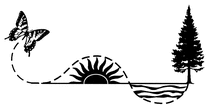This website is an online educational component of the UM extension and research program of Dr. Vera Krischik, Extension Specialist and Associate Professor, Department of Entomology, University of Minnesota, [email protected].
Welcome to CUES, Center for Urban Ecology and Sustainability! You will find practical information on IPM, insect identification, insecticide choice, and conserving beneficial insects in greenhouse, hoop houses, nurseries, landscapes, and Christmas trees. A second website on IPM programs and pesticides to conserve bees, butterflies, and beneficial insects can be found at "Conservation of Pollinators" Also, this website contains a section on identifying pests and beneficial insects in greenhouses, nurseries, and hoop houses at "Greenhouse IPM"
Under 4 different buttons at the top of the website is the manual "IPM of Midwest Landscapes". It contains identification and management information for over 150 insect pests of trees, herbaceous plants, turf, and beneficial insects.
Click the button "IPM for Professionals" to view several presentations and publications we have created, including a bulletin entitled "2020 Updated Krischik Insecticide Toxicity to Pollinators". In addition you can explore pesticide information through the CDMS website for pesticide labels sorted by trade name, the Kelly Solutions website on pesticides registered in Minnesota, and the Koppert website on pesticide compatibility with beneficial insects. We also have a section devoted to Christmas Tree pest management. Read the "USDA Forest Service Manual on Christmas Tree Pests", a presentation from us on "IPM of Firs", Pennsylvania Department of Agriculture pesticide recommendations for insecticides and fungicides, and Pacific Northwest recommendations on herbicides.
A Certification course for learning information need to pass the MN Department of Agriculture (MDA) pesticide license exam is provided in person and online every March and April for studying for the MDA pesticide license in category A (general) and category E (turf and ornamnetals) Go to MNLA , MN Nursery and landscape Association, to register for the course at MNLA under educational events. Also, listed are recertifcation courses that must be taken every other year to maintain the pesticide certification license. It is hosted by MDA, MNLA, and University of Minnesota Pesticide Safety group. Workshops are available for registration at commercial and noncommercial pesticide applicator. Sign up for a MDA Pesticide License Exam.
An online course with an IPM certificate is in the process of being constructed.
CUES Mission Statement

CUES strives to educate landscape managers and urban residents about ways to embrace environmental stewardship by practicing sustainable management. A landscape managed through sustainable methods requires low inputs of labor, fertilizers, herbicides, insecticides, and fungicides, while supporting beneficial insects, bees, butterflies, and birds. Excessive use of these chemicals can pollute surface and ground water and disturb natural ecosystem processes.
Sustainable management embraces four major principles:
Conserving biodiversity
The naturally diverse landscape discourages outbreaks of disease or insects. Such a landscape also attracts beneficial insects, bees, birds and butterflies.Restoring native vegetation
Consider using native vegetation in landscapes. Restore native vegetation to shorelines to reduce nutrient enrichment through stabilizing sediments and shorelines.Promoting nutrient recycling through composting
Backyard and community composting is an ecologically sound way of disposing of yard wastes and increasing nutrients in urban soils.Using integrated pest management, IPM, to control insects and diseases
Inspect and monitor your plants' health on a regular basis, before problems are out of control. Instead of routinely spraying for insects, use spot treat problems of soft pesticides such as soaps, oils, and biorational products such as spinosad. Adopt these biorational practices which target the pest and not the naturally occurring biological control agents, such as parasitoids and predatory insects. Use naturally resistant plants. When necessary use hard pesticides, timed to the vulnerable stage of the insect, so the application has a major impact on the pest.A Minnesota Extension Service Collegiate grant in 1995 funded the creation of CUES, Center for Urban Ecosystems and Sustainability. CUES is an interdisciplinary program with participants from the Colleges of Agriculture, Food, and Environmental Sciences; Biological Sciences; Natural Resources; and Landscape Architecture.
Please contact University of Minnesota Extension Specialist Vera Krischik for more information and help on IPM of landscapes, nurseries, greenhouses, and Christmas trees at [email protected]

